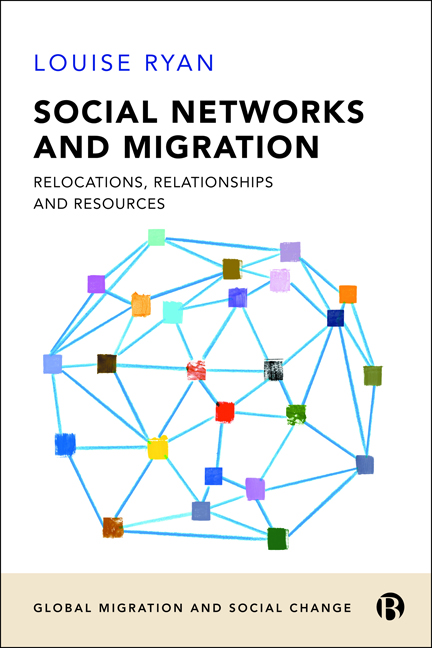Book contents
- Frontmatter
- Contents
- List of Figures
- About the Author
- Acknowledgements
- 1 Introduction: Embarking on a Book about Networks
- 2 Conceptualising Migrant Networks: Advancing the Field of Qualitative Social Network Analysis
- 3 Researching Migration and Networks: Empirical and Methodological Innovations
- 4 Social Networks and Stories of Arrival
- 5 Employment, Deskilling and Reskilling: Revisiting Strong and Weak Ties
- 6 Evolving Networks in Place over Time: A Life Course Lens
- 7 Transnational Ties: Narrating Relationality, Resources and Dynamics over Time
- 8 Conclusion: Thoughts and Future Directions
- Appendix
- Notes
- References
- Index
5 - Employment, Deskilling and Reskilling: Revisiting Strong and Weak Ties
Published online by Cambridge University Press: 18 January 2024
- Frontmatter
- Contents
- List of Figures
- About the Author
- Acknowledgements
- 1 Introduction: Embarking on a Book about Networks
- 2 Conceptualising Migrant Networks: Advancing the Field of Qualitative Social Network Analysis
- 3 Researching Migration and Networks: Empirical and Methodological Innovations
- 4 Social Networks and Stories of Arrival
- 5 Employment, Deskilling and Reskilling: Revisiting Strong and Weak Ties
- 6 Evolving Networks in Place over Time: A Life Course Lens
- 7 Transnational Ties: Narrating Relationality, Resources and Dynamics over Time
- 8 Conclusion: Thoughts and Future Directions
- Appendix
- Notes
- References
- Index
Summary
Having examined initial migration plans and stories of arrival in Chapter 4, the focus now shifts to networks and employment seeking post-arrival. Within migration studies, there has been considerable interest in the role of migrant networks in accessing employment (Massey, 1986; Boyd, 1989; Curran et al, 2005, to name a few). Moreover, there has been much discussion about the benefits but also the potential disadvantages of coethnic ties in facilitating labour market access (Smith, 2005; Nannestad et al, 2008). Over-reliance on ethnic-specific networks may result in a funnelling effect into niche jobs, downward mobility and economic disadvantage, as well as possible exploitation (Anthias and Cederberg, 2009; Thondhlana, Madziva and McGrath, 2016). Drawing on social network literature, some migration scholars have examined the importance of weak ties in helping migrants to forge more diverse and advantageous social connections as a way of increasing job opportunities (Lancee, 2010; Ryan, 2011a; Patulny, 2015; Gericke et al, 2018; Bernhard, 2020). Weak ties are often configured in the migration literature as bridging ethnicity – that is, ties to people outside the ethnic enclave (Lancee and Hartung, 2012; Damstra and Tillie, 2016).
My work has cautioned against a reductive approach that conflates tie strength with ethnic composition (Ryan, 2011a; 2016). As noted in Chapter 2, it cannot be assumed that ties to co-ethnics are necessarily strong, while ties to so-called ‘natives’ are necessarily weak. Moreover, the social capital inhering in these ties cannot be taken for granted. Instead, it is important to look more closely at the relationships between people and the kinds of resources flowing between them. Furthermore, as my research over many years has shown, not all ‘weak ties’ are beneficial. Simply forging diverse social connections is no guarantee of enhancing employment opportunities. As discussed in Chapter 2, my work draws on network theorists such as Granovetter, Burt and Lin to critically interrogate what is meant by weak ties. Analysing relative social location, I have differentiated between horizontal and vertical weak ties (Ryan, 2011a). In other words, weak ties are more likely to be advantageous if connections are vertical (that is, to those in a higher social position).
Information
- Type
- Chapter
- Information
- Social Networks and MigrationRelocations, Relationships and Resources, pp. 81 - 103Publisher: Bristol University PressPrint publication year: 2023
